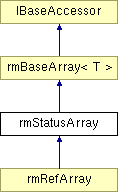
#include <rmStatusArray.h>
Inheritance diagram for rmStatusArray:

Public Methods | |
| rmStatusArray () | |
| virtual | ~rmStatusArray () |
| virtual int | addDefaultElement (unsigned long aID) |
| add a default element into the table. More... | |
| virtual int | updateStatus (T &aElement) |
| update the status of an element. More... | |
| virtual int | setStatus (T &aElement, unsigned long aID, long aStatus) |
| set the status of an element. More... | |
The datatype for this template class must have a member named "status". This member will be used by SNMP Subagent to manage the current status of the element.
Valid "status" are: ACTIVE, NOTINSERVICE, NOTREADY Other commands including: CREATEANDGO, CREATEANDWAIT, DESTORY.
Definition at line 20 of file rmStatusArray.h.
|
|||||||||
|
Definition at line 23 of file rmStatusArray.h. |
|
|||||||||
|
Definition at line 24 of file rmStatusArray.h. |
|
||||||||||
|
add a default element into the table. Add a default element into the table without providing a real element. The new element will contain default values. And the status of the newly created element will be set to NOTREADY.
Reimplemented from rmBaseArray. Reimplemented in eventQuery. Definition at line 55 of file rmStatusArray.h. References rmBaseArray::addElement, and NOTREADY. |
|
||||||||||||||||||||
|
set the status of an element. Set the status of an element.
Definition at line 115 of file rmStatusArray.h. References ACTIVE, NOTINSERVICE, NOTREADY, RMCLIENT_ERROR_NOSUCHVALUE, RMCLIENT_ERROR_STATE, and RMCLIENT_SUCCESS. |
|
||||||||||
|
update the status of an element. Update the status of an element. This function utilizes elementIsReady() to test if the element is ready for service. The status will be set according to the previous status and the result of elementIsReady() call.
Definition at line 84 of file rmStatusArray.h. References ACTIVE, rmBaseArray::elementIsReady, NOTINSERVICE, NOTREADY, and RMCLIENT_SUCCESS. |
 1.2.14 written by Dimitri van Heesch,
© 1997-2002
1.2.14 written by Dimitri van Heesch,
© 1997-2002